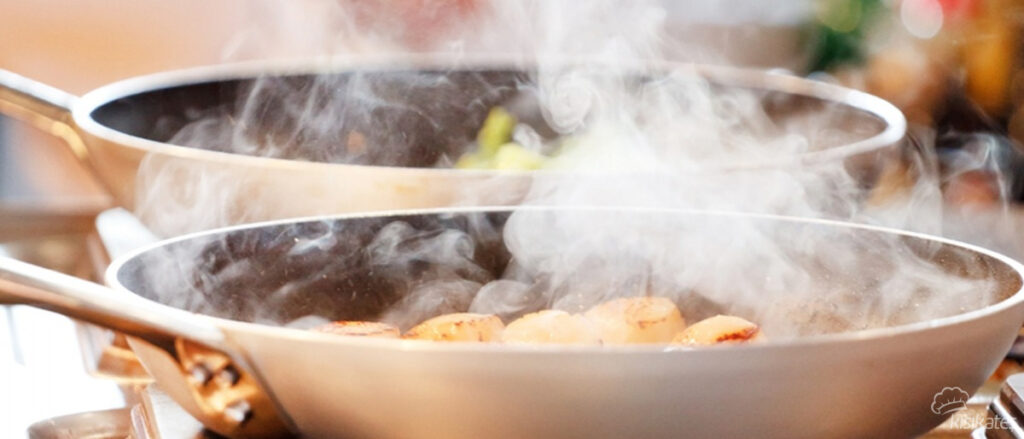We often expect delicious meals to be prepared by a chef. However, sometimes even the most delectable dishes can ruin your night, or worse, land you in the hospital. Good nutrition leads to good performance and productivity, but the opposite can result in unwanted consequences.
Individual hygiene and environmental cleanliness are crucial for a chef. Appropriate attire that suits the job is essential. Having a sense of aesthetics and orderliness is important.
Being innovative and creative is key. Being a smart worker and a team player is necessary.
Basic Cooking Techniques: Boiling, Frying, Steaming
Foods are often prepared for consumption by changing their physical or chemical structures through heat. A good chef is not only a skilled cook but also a creator of new recipes.
Recognizing the product and deciding on suitable cooking techniques is the first step towards culinary mastery. The highest quality of a dish lies in respecting the ingredients and achieving technical perfection.
Here are the details of some basic cooking techniques:
Boiling Method
This technique involves cooking foods in liquid brought to a boiling point. The liquid can be water, broth, chicken stock, or milk.
There are three different methods of boiling:
- Foods are added to boiling water and boiled until they reach a boil again. Then the heat is reduced, and the cooking process continues.
- Foods are added to cold liquid and then brought to a boil. The heat is reduced afterward for continued cooking.
- Anti-shock method for vegetables and fruits: This method involves submerging the produce in boiling water for 4 minutes, then immediately transferring them to ice water for another 5 minutes. This process helps preserve the proteins, minerals, and colors of the produce.
Simmering Method
Small pieces of food are cooked in a small amount of liquid over low heat. The dish is served with the liquid it was cooked in. Simmering is one of the safest methods, preserving the nutrients of the food. It involves cooking in a covered pot at low heat, either on the stovetop or in the oven.
Steaming Method
Foods are cooked with the help of steam. This method results in minimal nutrient loss and easy digestion. The appearance and shape of the foods are preserved since there is no direct contact with water.
To steam food, a large pot with water is brought to a boil, and a perforated container or a special steaming basket is placed over it. The food is then covered with a lid until it becomes tender.
Baking Method
This method involves cooking foods in the oven. The baking temperature varies for different dishes and must be pre-set accordingly.
Frying Method
Foods are fried in oil, either deep-frying or shallow-frying. Due to its potential for nutrient loss and contributing to cardiovascular diseases, frying is not often preferred.
Grilling Method
Foods are cooked by direct contact with heat, either on a grill or in the broiler section of an oven. This method is known for producing flavorful dishes, and the cooking temperature can be adjusted to personal taste.
Kitchen Equipment and Uses
The taste of a dish can vary depending on the equipment and tools used. Knowing the commonly used kitchen equipment and tools can enhance the flavor of a meal.
Familiarizing yourself with the basics can make cooking enjoyable. From meal preparation to serving, the kitchen, considered the heart of the home, encompasses the entire process. Would you like to make cooking enjoyable by selecting the right equipment?
Here is some information about the elements of the kitchen and their uses:
- Knife set
- Pot and Pan Set
- Cutting Board
- Pot Lids
- Mixing Spoon and Utensil Set
- Cutting, Grating, and Peeling Tools
- Mixer or Hand Whisk
- Cooking Utensils
- Microwave Oven
- Blender
- Kitchen Scale
- Kettle or Electric Kettle
- Covers and Kitchen Towels
- Jars and Storage Containers
- Cutlery Set
Ingredient Selection and Preparation
Effortless serving, whether in a restaurant or at home, requires ingredients to be ready for presentation, and dishes to be easily adjusted by chefs. Additionally, having sauces and accompanying ingredients ready during cooking and serving is crucial.
The number of ingredients, even for complex recipes, requires meticulous planning to avoid errors. Coordination of multiple tasks is essential. Starting the day with planning is crucial.
Unnecessary steps should be avoided, and good timing plays a significant role in ingredient selection and preparation. A chef’s effective performance in choosing and preparing ingredients according to a plan before service is vital. All food items should not be kept waiting excessively beyond the designated temperature range.
Selecting appropriate tools and equipment should also be part of the plan. Choosing the right tools and equipment has many benefits. Mise en place, having everything in its place, is an important step.
It aims to ensure that the tools required for preparing the recipe are gathered and function efficiently. Here are the necessary steps for ingredient selection and preparation:
Read and review the recipe for the ingredients needed. Follow the instructions for using all equipment and work surfaces. Ensure all equipment and work surfaces are clean.
Use equipment only for its intended purpose. Ensure cutting tools are sharp and well-maintained. Periodically check the accuracy of measuring tools.
Preheat ovens and cooking surfaces as necessary. Ensure mixing bowls, storage containers, and pots are of appropriate sizes. Keep kitchen tools, utensils, serving plates, etc., close at hand for easy access.
The kitchen is a place of fast-paced and skilled processes. Establishing a well-organized process is crucial. The importance of basic knowledge for culinary mastery cannot be overstated.
Therefore, in gastronomy education, the selection of basic knowledge and the choice of equipment and tools play an important role.
See you in the next post,
Anil UZUN

